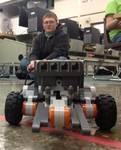

News Sentinel correspondent
BRIGHAM CITY – Classes are out, the school day is over and Box Elder Middle School technology teacher Matt Williams still has to push the robotics club members out the door.
“They’re all my favorites,” Williams said during a recent interview in the technology classroom. “All of them will go far.”
The Box Elder after-school club is part of a long-term program intended to teach the students creative problem solving and invention by planning, designing and building robots. The projects are designed to foster students’ interest in technology.
These students don’t like to leave the classroom because they like solving technical problems. Hayden Turner, 14, says the robotics projects are still the hardest thing they do in school because there are no set rules about how something can be done.
Thirty students signed up for the club this year, and 21 stayed on as regular members, Williams said, which is unusual for an after-school club that doesn’t end until 4 p.m.
Most members of this club are eighth graders, but the robotics program also exists in elementary and high school.
The LEGO MindStorms Robotics Invention System used in Williams’ classroom was designed in 2006 as a cooperative project between LEGO and Massachusetts Institute of Technology.
There’s no robot hall of fame here. After the machines are built and tested, the parts are cannibalized to use in the next project. Only the memory remains of the robot Santa Claus who whipped robot Rudolph as they moved across the room. David Anderson’s robotic Rubics Cube solver is now part of his three-gear transmission.
Likewise, no will ever know how Katie Cronin’s and Emily Harames’ little robot puppy died – each girl blames the other, then laughs. It had laser and color sensors, Katie said. The girls are now working together on a remote control lawn mower.
“Girls tend to be more particular about their projects; they’re more methodical,” Williams said. “Boys like to get it moving and then go back and fix it.”
The robots can be programmed to navigate obstacles, follow trails or react to changes in light. A lot of project directions can be found on YouTube, William said, but the students will take those instructions and modify them.
Among other things, B.J. Bruner is working on a robotic arm for the soccer game on May 24 against the Adele C. Young Intermediate school sixth and seventh graders. The soccer bots pass a red plastic ball to each other across a field outlined on the floor or push or kick the ball to the soccer goal.
Adam Thompson is trying to get a mine sweeper robot to pick up the mines – in this case, small blocks – and throw them in the back of the vehicle.
“If we can get it working, it will work by itself,” he said.
Keaton Call, 15, is the club’s only a ninth grade student. He recently made a piston engine that ran off a vacuum that he turned into a generator.
The next step is to go to Mars. The technology classroom has an old radio station studio Williams plans to modify to look like the Martian landscape. Since the studio is behind glass, the students will not be able to reach in and adjust their Mars rovers to get over rocks or out of ditches.
“They’re doing some impressive things,” Williams said.